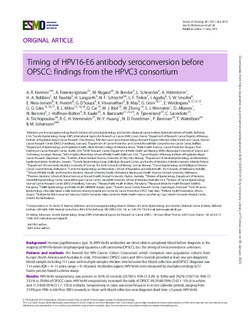| dc.contributor.author | Kreimer, Aimée R. | |
| dc.contributor.author | Ferreiro-Iglesias, Aida | |
| dc.contributor.author | Nygård, Mari | |
| dc.contributor.author | Bender, Noemi | |
| dc.contributor.author | Schroeder, Lea | |
| dc.contributor.author | Hildesheim, Alan | |
| dc.contributor.author | Robbins, Hilary A. | |
| dc.contributor.author | Pawlita, Michael | |
| dc.contributor.author | Langseth, Hilde | |
| dc.contributor.author | Schlecht, Nicolas F. | |
| dc.contributor.author | Tinker, Lesley Fels | |
| dc.contributor.author | Agalliu, Ilir | |
| dc.contributor.author | Smoller, Sylvia W. | |
| dc.contributor.author | Ness-Jensen, Eivind | |
| dc.contributor.author | Hveem, Kristian | |
| dc.contributor.author | D'Souza, Gypsyamber | |
| dc.contributor.author | Visvanathan, Kala | |
| dc.contributor.author | May, Betty | |
| dc.contributor.author | Ursin, Giske | |
| dc.contributor.author | Weiderpass, Elisabete | |
| dc.contributor.author | Giles, Graham G. | |
| dc.contributor.author | Milne, Roger L. | |
| dc.contributor.author | Cai, Qiuyin | |
| dc.contributor.author | Blot, William J. | |
| dc.contributor.author | Zheng, Wei | |
| dc.contributor.author | Weinstein, Stephanie J. | |
| dc.contributor.author | Albanes, Demetrius | |
| dc.contributor.author | Brenner, Nicole | |
| dc.contributor.author | Hoffman-Bolton, Judith | |
| dc.contributor.author | Kaaks, Rudolf | |
| dc.contributor.author | Barricarte, Aurelio | |
| dc.contributor.author | Tjønneland, Anne | |
| dc.contributor.author | Sacerdote, Carlotta | |
| dc.contributor.author | Trichopoulou, Antonia | |
| dc.contributor.author | Vermeulen, Roel C.H. | |
| dc.contributor.author | Huang, Wen-Yi | |
| dc.contributor.author | Freedman, Neal D. | |
| dc.contributor.author | Brennan, Paul J. | |
| dc.contributor.author | Waterboer, Tim | |
| dc.contributor.author | Johansson, Mattias | |
| dc.date.accessioned | 2020-01-13T08:20:32Z | |
| dc.date.available | 2020-01-13T08:20:32Z | |
| dc.date.created | 2019-10-18T15:41:44Z | |
| dc.date.issued | 2019 | |
| dc.identifier.citation | Annals of Oncology. 2019, 30 (8), 1335-1343. | nb_NO |
| dc.identifier.issn | 0923-7534 | |
| dc.identifier.uri | http://hdl.handle.net/11250/2635827 | |
| dc.description.abstract | Background
Human papillomavirus type 16 (HPV16)-E6 antibodies are detectable in peripheral blood before diagnosis in the majority of HPV16-driven oropharyngeal squamous cell carcinoma (OPSCC), but the timing of seroconversion is unknown.
Patients and methods
We formed the HPV Cancer Cohort Consortium which comprises nine population cohorts from Europe, North America and Australia. In total, 743 incident OPSCC cases and 5814 controls provided at least one pre-diagnostic blood sample, including 111 cases with multiple samples. Median time between first blood collection and OPSCC diagnosis was 11.4 years (IQR = 6–11 years, range = 0–40 years). Antibodies against HPV16-E6 were measured by multiplex serology (GST fusion protein based Luminex assay).
Results
HPV16-E6 seropositivity was present in 0.4% of controls (22/5814; 95% CI 0.2% to 0.6%) and 26.2% (195/743; 95% CI 23.1% to 29.6%) of OPSCC cases. HPV16-E6 seropositivity increased the odds of OPSCC 98.2-fold (95% CI 62.1–155.4) in whites and 17.2-fold (95% CI 1.7–170.5) in blacks. Seropositivity in cases was more frequent in recent calendar periods, ranging from 21.9% pre-1996 to 68.4% in 2005 onwards, in those with blood collection near diagnosis (lead time <5 years). HPV16-E6 seropositivity increased with lead time: 0.0%, 13.5%, 23.7%, and 38.9% with lead times of >30 years (N = 24), 20–30 years (N = 148), 10–20 years (N = 228), and <10 years (N = 301 cases) (p-trend < 0.001). Of the 47 HPV16-E6 seropositive cases with serially-collected blood samples, 17 cases seroconverted during follow-up, with timing ranging from 6 to 28 years before diagnosis. For the remaining 30 cases, robust seropositivity was observed up to 25 years before diagnosis.
Conclusions
The immune response to HPV16-driven tumorigenesis is most often detectable several decades before OPSCC diagnosis. HPV16-E6 seropositive individuals face increased risk of OPSCC over several decades. | nb_NO |
| dc.language.iso | eng | nb_NO |
| dc.publisher | Elsevier | nb_NO |
| dc.rights | Navngivelse-Ikkekommersiell 4.0 Internasjonal | * |
| dc.rights.uri | http://creativecommons.org/licenses/by-nc/4.0/deed.no | * |
| dc.title | Timing of HPV16-E6 antibody seroconversion before OPSCC: Findings from the HPVC3 consortium | nb_NO |
| dc.type | Journal article | nb_NO |
| dc.type | Peer reviewed | nb_NO |
| dc.description.version | publishedVersion | nb_NO |
| dc.source.pagenumber | 1335-1343 | nb_NO |
| dc.source.volume | 30 | nb_NO |
| dc.source.journal | Annals of Oncology | nb_NO |
| dc.source.issue | 8 | nb_NO |
| dc.identifier.doi | 10.1093/annonc/mdz138 | |
| dc.identifier.cristin | 1738537 | |
| dc.relation.project | Stiftelsen Kristian Gerhard Jebsen: SKGJ-MED-015 | nb_NO |
| dc.description.localcode | Copyright The Author(s) 2019. Published by Oxford University Press on behalf of the European Society for Medical Oncology.AnnalsofOncology30: 1335–1343, 2019doi:10.1093/annonc/mdz138Published online 11 June 2019This is an Open Access article under the CC-BY-NClicense. | nb_NO |
| cristin.unitcode | 194,65,20,15 | |
| cristin.unitname | Helseundersøkelsen i Nord-Trøndelag | |
| cristin.ispublished | true | |
| cristin.fulltext | original | |
| cristin.qualitycode | 2 | |

